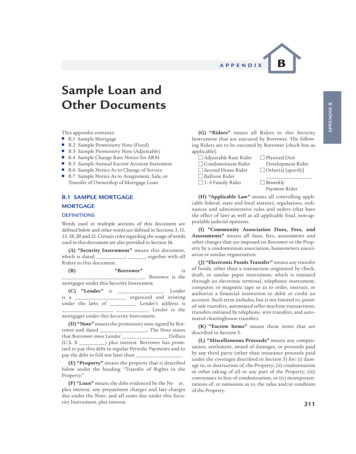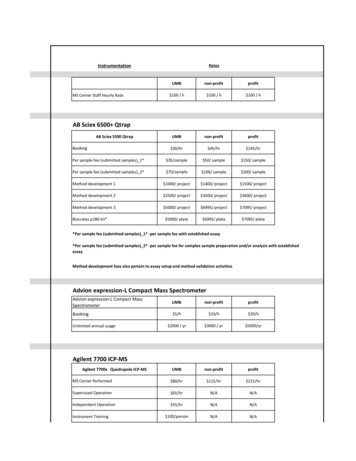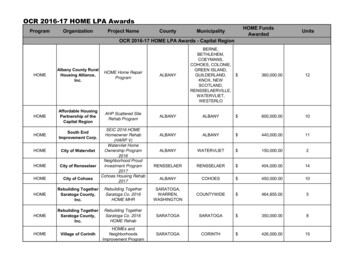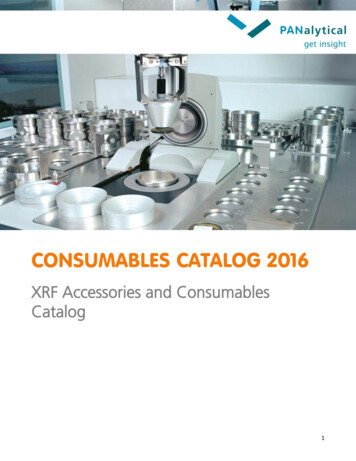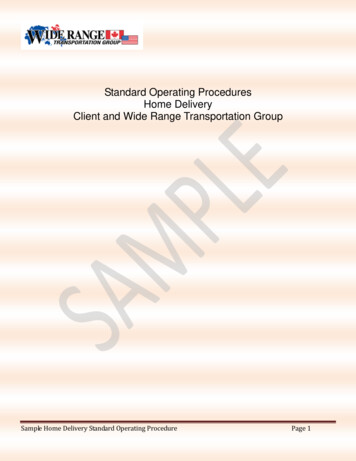
Transcription
Standard Operating ProceduresHome DeliveryClient and Wide Range Transportation GroupSample Home Delivery Standard Operating ProcedurePage 1
Table of Content1 Introduction.42 Local Customer Delivery.42.1 LCD Delivery Models. .42.1.1 Same Day delivery from store front. .42.1.2 Next Day delivery from store front.42.1.3 Orders transported from the store to the TSP’s facility for delivery to the customer (future and remotedeliveries).52.1.4 Additional information. .52.2 Planning & Transport Booking. .52.3 Transport desk.52.4 Loading at Store.62.4.1 Store Front Delivery Staging and Loading Standards.62.4.2 STAGING AND LOADING - LCD Orders to go to TSP’s Facility.72.5 Loading unit quality & equipment.82.6 Documentation. .82.7 Customer Distribution. .83 Central Customer Delivery.83.1 Planning & Transport Booking. 93.2 LoadingSpecifications (LS).93.3 Customer Areas. .93.4 Transport booking trunkline.93.4.1 Changes in Transport booking. .93.4.2 Confirmation of Transport booking.93.4.3 Cancellation of Transport Booking.1 03.5 CCD Transport Models.103.5.1 Push and Pull.103.5.2 Push.103.5.3 Pull. .103.6 Loading at CDC.113.6.1 Loading unit quality & equipment.113.6.2 Loading unit check.113.6.3 Live loading.113.6.4 Non live loading.113.6.5 Sealing. .113.7 Documentation. .113.8 Import and Export. .123.8.1 Export clearance & Border crossings.123.8.2 Import clearance.123.9 Unloading at Transport Service Provider.123.9.1 Unsealing.123.9.2 Live unloading. .123.9.3 Non Live Unloading.123.9.4 Receiving the Orders. .133.9.5 Preparing for delivery.134 Customer Distribution (LCD and CCD).134.1 Unloading at Customer Location.144.2 Service Types.144.3 Extra service.14Sample Home Delivery Standard Operating ProcedurePage 2
4.4 Merged Orders. .144.5 Pick-up Point.144.6 Additional service. .164.7 Customer payments.16Page 2 of 20 Standard Operational Procedure North AmericaSample Home Delivery Standard Operating ProcedurePage 3
4.8 Big orders.175 Delivery Deviations (LCD and CCD).175.1 Before delivering to Customer.175.2 Waiting time at client Location.175.3 Waiting time at Customer.175.4 Unsuccessful delivery. .175.4.1 Customer is not at home.175.4.2 In-route cancellation or complete refusal.185.4.3 Partial refusal.185.5 Property Damage during delivery to Customer.186 Returns.186.1 External returns.186.2 Internal returns.197 Handling Materials.198 IT and Invoicing.198.1 IT.209 Inventory & Performance Follow ups.209.1 Inventory.20Sample Home Delivery Standard Operating ProcedurePage 4
1 IntroductionThis document Standard Operational Procedures (SOP) is an appendix to the “Customer DeliveryService Agreement” and applies to all transport services under the “Customer Delivery ServiceAgreement”. The document describes the standard operational procedures and requirements forperforming the requested services.Any exceptions to the procedures are found in the “Customer Delivery Service Agreement” or otherspecified appendices. Chapter 2 in this SOP is not applicable for Central Customer Deliveries, chapter 3-5is not applicable for Local Customer Deliveries, and chapter 6-10 is applicable for both Central CustomerDeliveries and Local Customer Deliveries.Local Customer DeliveryLocal Customer Delivery is the service provided when a Customer makes a purchase at the store andchooses to have the products purchased that day delivered to their home. The service offer should beprovided by the service provider all days when the Stores are open.2.1 LCD Delivery Models2.1.1 Same Day delivery from store frontThis requires the TSP to pick up merchandise that is purchased by a customer at the storethat day. The TSP organizes the routes and then delivers to the customer the same day asthe purchase directly from the store front. Customer makes a purchase at the store Delivery time (4 hour delivery window i.e. 5pm-9pm) is confirmed with the customer Same Day Delivery service must be available 7 days a week There is to be an agreed cut off time for same day deliverieso Set between the store and TSP Order information is sent to the TSP at the agreed cut off time via Electronic Data Interchange (EDI)2.1.2 Next Day delivery from store frontCustomer makes a purchase at the store and arranges with the store to have the goods delivered the nextday.Delivery date and choice of one of three, 4 hour delivery window time frames (i.e. 9am-1pm, 1pm-5pm,5pm-9pm) is set at the store with the customer for deliveries in the zones determined between client andTSP (80% of historical orders need to be covered with this service)Page 4 of 20 Standard Operational Procedure North AmericaSample Home Delivery Standard Operating ProcedurePage 5
Next Day Delivery service must be available 7 days a week and offered with three, 4 hour deliverywindows.Order information is sent to the TSP via Electronic Data Interchange (EDI): Files may be sent one or moretimes a day.Cut-off time is always after store closing to enable “Buy it today, get it tomorrow” for deliveries within theNext Day zones .2.1.3 Future and/or Remote DeliveriesFuture Orders that are serviced within the Next Day zones will be held at the storeand shipped from the store for the future day of delivery. Future orders that falloutside of the Next Day zones and Remote deliveries will be transported from thestore to the TSP’s facility for delivery to the customer1. Customer makes a purchase at the store2. The delivery date (and one of three, 4 hour time window for the Next Day zones) for futuredelivery date orders is set at the store.3. The delivery date for remote orders may or may not be set depending on TSP schedule.4. Delivery service must be available 6 days a week at minimum5. Order information and delivery orders will be received by the TSP via Electronic DataInterchange (EDI) the day of purchase6. Palletizing of any goods to be stored at the TSP’s warehouse is to be done by the TSP withmaterials supplied by the TSP at the time it is picked up for transport from the Store to the TSPhub.2.1.4 Additional informationAdditional information such as actual cut-off times, pick up schedules, etc., as well as changes, additionsor deletions will be agreed upon between client and TSP.2.2 Planning & Transport BookingAll bookings of delivery service takes place after the articles being purchased by the Customer at thetransport desk.2.3 Transport deskThe transport desk is served by client during the opening hours at the Store. Client offers the serviceagreed between client and the service provider to the Customer, book the arrangement with theCustomer, collect payment and take over the responsibility of the articles from the Customer until thearticles are received by the TSP at the yellow line. Page 5 of 20 Standard Operational Procedure North AmericaSample Home Delivery Standard Operating ProcedurePage 6
The Store offers an area where the booked deliveries are stored and where the deliveries are kept untilthey are loaded for distribution to Customer or transport to TSP hub.2.4 Loading at StoreThe Service Provider is responsible for the loading procedures and is allowed to co-load the client goodswith other goods provided that the other goods do not jeopardise safe and undamaged transportation ofthe client goods. All equipment (including handling material) needed for loading and securing of goods isthe responsibility of the TSP. client co-workers will not assist in loading.2.4.1 Store Front Delivery Staging and Loading StandardsThe Carrier drivers shall report to the client Location per the Store Service Agreement each scheduleddelivery day for loading their vehicles. If drivers wish to pre-load the night before, approval must beobtained from the Logistics Manager.Only delivery drivers, assistants, the on-site Carrier representative or Account Manager are allowed to beon the premises unless prior approval has been given by a Customer Delivery Manager or a CDCManager for others to be present.Drivers are to enter the employee entrance and sign in before accessing client property to load theirdelivery vehicle.During the loading process, the delivery crew is responsible for securing and protecting the products toavoid in-transit damages.The delivery crew shall be solely responsible for and perform the loading of the delivery vehicles. An clientStore supervisor or co-worker will oversee the loading process. The delivery crew is responsible to verify each order they are receiving during the loading process for:o Correct order numbero Correct articleso Correct quantityo Visible damagesThe client Store Customer Delivery Manager must be notified immediately of any discrepancies ordamages discovered byPage 6 of 20 Standard Operational Procedure North AmericaSample Home Delivery Standard Operating ProcedurePage 7
the Carrier employees while loading the delivery trucks. client will investigate and correct the situationprior to the delivery crew leaving the client Store, Local Service Center or CDC. It is up to the discretion ofthe client delivery coordinator or supervisor to replace or not replace an item reported as damaged by thedriver. If a damaged article is not replaced following notification of client delivery coordinator or supervisor,liability is transferred to client.Once the driver has verified all orders and loaded them onto the delivery truck, the TSP is responsible forany missing items and damages that occur after the loading of the truck This will apply to orders that arenot shrink wrapped. In cases where the order is shrink wrapped, Carrier will only be responsible for anymissing items at the order level.The yellow line is once the driver has loaded the order for delivery to the customerNo carts are ever to leave the client store.2.4.2 STAGING AND LOADING - LCD Orders to go to TSP’s FacilityCarrier will provide a store shuttle sweep per the Store Service Agreement as volume warrants.Orders must be prepared by the TSP for the shuttle truck so as to ensure the products are not damaged intransit the Carriers facility, using their own handling material.No carts are ever to leave the client store.The Carrier is responsible to verify they receive the orders on the manifest and that there are no visibledamages presentclient must be notified immediately if there are any missing orders or visible damages before they areloaded on the truck.A manifest listing all orders that are being transferred to the Carriers facility is to be signed by both clientand the Carriers agent before leaving client. A copy of the signed manifest is retained by both client andthe Carrier.The yellow line is when the TSP loads the order on the shuttle truck for transport to their hub.Page 7 of 20 Standard Operational Procedure North AmericaSample Home Delivery Standard Operating ProcedurePage 8
2.5 Loading unit quality & equipmentThe Service Provider undertakes to check, and takes responsibility, that the loading unit is suitable for thekind/s of transport that will be performed. It must not be damaged, wet, and dirty or in other respects in acondition that could jeopardize a safe transportation and condition of the goods. The Service Providermust make available straps or loading bars suitable for the loading unit type provided in order to minimizethe risk for losses and damage during transportation.Delivery vehicles shall operate with no identifying logo, client or otherwise, and shall be white in color. Thedelivery vehicles may have the logo of the delivery company, but no other company’s name or informationmay be on the trucks except where required by law.2.6 DocumentationThe client store will provide a delivery order for the driver when the orders are picked up for delivery to thecustomer or for transport to the TSP hub. This is the form the customer is to sign and then scanned in it’sentirety and saved by the TSP. Proof of delivery must be sent to the no later than the day after the deliverywas made.2.7 Delivery to the CustomerDelivery to the customer, is described in Chapter 4.Central Customer Deliveryclient or a Service Provider contracted by client transports the goods from a stock location in a centralwarehouse, i.e. CDC or other central point such as a supplier, on behalf of the Customer to his/her homeor to a Pick-up Point.The Customer orders are placed via client, taking the CDC and transport capacity into consideration.Thereafter the Customer orders are received and handled by the CDC; the order starts during thisprocess, depending on EDI integration, to be visible for the Transport Service Provider (TSP) andCustomer. After this process the Customer orders are placed as CDU’s at the dispatch area, yellow line,and are ready to be picked up by the TSP or the carrier responsible for loading at the CDC. The goods arethereafter transported to the TSP Hub where its unloaded and reloaded for distribution to Customer, inspecific cases there could be agreed direct deliveries from the CDC directly to the Customer defined inthe “Customer Delivery Service Agreement”. Delivery takes place and delivery documents are signedby Customer, in some cases Customer payments as well are handled, deviations are handled by clientCustomer Service.Page 8 of 20 Standard Operational Procedure North AmericaSample Home Delivery Standard Operating ProcedurePage 9
3.1 Planning & Transport BookingShipments will be received on preset dates agreed to with client and the TSP and stated in the CDCService Agreement.Shipments need to be received by the Carrier Monday through Saturday and Sunday if needed toaccommodate peak periods.3.2 LoadingSpecifications (LS)A loading specification is a group of Customer deliveries, planned for one loading unit leaving CDC to TSPHub, they are created by client before departure from CDC.Carrier will receive customer order information when the order has been loaded at the CDC for shipmentto the CarrierOnce the order information is received, the Carrier may contact the customer and schedule the deliverybased on the date the order is scheduled to be received at the Carriers facility3.3 Customer AreasThe loading specifications are steered by the Customer areas agreed by client and the TSP. A Customerarea is a group of zip-codes representing a delivery area for e.g. a distribution unit, and are used whencreating the loading specification, when picking the orders and when loading, in order to separate theCustomer orders and make distribution as efficient as possible.3.4 Transport booking trunklineClient will contract the trunkline to the TSP facilities outside of this agreement.3.4.1 Changes in Transport bookingClient reserves the right to change the transport booking for trunkline until 14:00 (local time) the week-dayprior departure from CDC. The changed transport booking will be re-sent by preferred mean ofcommunication and the original shipment number will be kept. For changes to date and time, no extraexpenses to be charged when agreed notice given.3.4.2 Confirmation of Transport bookingThe TSP, or carrier responsible for loading at the CDC, is expected to carry out the transport service asrequested in the transport booking. The client transport planner must be notified in the event of hindrancesto, or changes in, the performance of the transport services in accordance with the transport booking.Such notification is to be made as soon as possible by telephone and followed Page 9 of 20 StandardOperational Procedure North AmericaSample Home Delivery Standard Operating ProcedurePage 10
up by preferred mean of communication. Client reserves the right to refuse changes made by the ServiceProvider and cancel the transport booking with no additional cost.EDI/Web bookings are to be confirmed in accordance with the EDI/Web service agreement stated in theCarrier Integration Guide.3.4.3 Cancellation of Transport BookingClient reserves the rights to cancel a transport booking for trunkline until 14:00 (local time) the week-dayprior to departure from CDC. No cost to be charged when agreed notice given. When insufficient notice isgiven, the cost of the cancelled shipment must not exceed the cancellation cost stated in the “CustomerDelivery Service Agreement” and be reported according to chapter Claims. The cancelled transportbooking will be re-sent by preferred mean of communication.3.5 CCD Transport Models3.5.1 Push and PullThe prices negotiated for this agreement are inclusive or using a push or pull scenario for orders that arenot scheduled with a delivery date at the point of sale.3.5.2 PushWhere all orders are shipped to the TSP hub based on the Client systems latest ship date to reach thecustomer in the shortest possible time unless they explicitly request a later delivery date.The TSP will receive the End of Day report when the orders are loaded for shipping and may contact thecustomers to schedule delivery once they are loaded.Delivery date and time window will be promised to the customer per the agreed time lines for the zip codearea it belongs to.3.5.3 PullWhere the day after the order is paid for by the customer, a Daily Order Report is sent to the TSP toschedule delivery with the customer.The TSP will send the loading specification based on orders to be delivered as outlined in the CDCService Agreement.Orders will be shipped based on delivery date to the customer. To ensure full trucks some orders may be“pulled forward” from the next delivery day and a result there could be some orders the TSP must store for24-48 hours.TSP must continuously work with the CDC to ensure maximum fill rates in the pull scenarioPage 10 of 20 Standard Operational Procedure North AmericaSample Home Delivery Standard Operating ProcedurePage 11
3.6 Loading at CDCAll loading of trunkline to the TSP will be done by Client.3.6.1 Loading unit quality & equipmentClient will transport orders to the TSP hub(s) in 53’ logistic track trailers or 53’ dry vans. The equipmentused will be based on the type of handling material used for the loads.Client may elect to “co-load” Customer Delivery orders on to linehaul trucks destine for an client store. Inthis case, the store will off load their merchandise and load the customer delivery orders back onto thetrailer for transit to the LSC hub.3.6.2 Loading unit checkWhenever loading units arrives for loading, or/and unloading, client will ensure that the sender/receivercarries out a loading unit check.3.6.3 Live loadingWhen a driver asks for the right of access to the ramp areas in order to personally witness the loading,this shall not be denied. In such a case the person concerned must be made aware that access is onlypermitted for said purpose. The driver must observe the local security and safety regulations.3.6.4 Non live loadingAll Non live loading will be done by client3.6.5 SealingIt is the responsibility of CDC to seal loading units according to clients routines on sealing full loads. TheTSP, or carrier responsible for loading at CDC, has the responsibility to ensure the seal number isrecorded on the waybill at place of receipt when a seal is present.3.7 DocumentationAfter loading, client will produce a waybill and specifications regarding the loading. The documentationshould follow the transport and be used during unloading at receiver.Page 11 of 20 Standard Operational Procedure North AmericaSample Home Delivery Standard Operating ProcedurePage 12
3.8 Import and Export3.8.1 Export clearance & Border crossingsExport clearance is handled by client, TSP is responsible to follow general rules.3.8.2 Import clearanceImport clearance is handled by client, TSP is responsible to follow general rules.3.9 Unloading at Transport Service Provider3.9.1 UnsealingThe seal shall be verified and broken by the receiver of the goods, if authorities during transport break theseal, the TSP, or carrier responsible for loading at CDC, is obliged to secure that there is a new seal puton the loading unit, state the new seal number on the waybill and give evidence thereof.Client reserves the right to refuse an unsealed loading unit that was sealed by the sender. The TSP, orcarrier responsible for loading at CDC, takes any costs incurred thereof unless evidence from thegoverning authorities is available and the new seal is validated and intact.3.9.2 Live unloadingWhen a driver asks for the right of access to the ramp areas in order to personally witness the unloading,this shall not be denied. In such a case the person concerned must be made aware that access is onlypermitted for said purpose. The driver must observe the local security and safety regulations. Free time forunloading is two hours, in the event of receiver failing to unload within the agreed free time then thisshould be reported according to chapter “Waiting time at CDC or TSP”.3.9.3 Non Live UnloadingWhenever loading units arrives for unloading the driver must ensure that the receiver carries out a loadingunit check. Damages must be stated on the loading unit checklist, “Equipment Checklist”, andcountersigned by the driver. In the event of receiver refusing to check the equipment, this must be statedon the waybill. The loaded loading unit is thereafter handed over to the receiver to be unloaded at a laterdate/time without the driver present.When collecting unloaded equipment, the driver must carry out an equipment check. Damages must bestated on the “Equipment Checklist”, and countersigned by the sender.Page 12 of 20 Standard Operational Procedure North AmericaSample Home Delivery Standard Operating ProcedurePage 13
3.9.4 Receiving the OrdersThe receiver is during unloading responsible to check the load against received documentation andreceived transactions, any discrepancies should immediately be reported to CDT Operations at the CDCwhich sent the shipment.Shipments will consist of single customer orders on a pallet or pallets and multiple customer orders on apallet. Pallets with more than one customer order on them must be deconsolidated and separated intoindividual customer orders for delivery or pick-up by the carrier. For every shipment received the TSP must complete and send back to client within 24 hours ofunloading, a load specification document. This document must indicate any discrepancies or damages atthe article level for mixed pallets and any visible damages on a full pallet order. In addition, in an effort toship “Neat and Clean” packages to our customers, any sub-perfect packaging must be noted as well.Attached to the report must be pictures of any damages and any load which is sub-par from the loadingperspective. The Carrier is responsible to verify each piece if it is a multiple customer pallet they are receivingduring the loading process for:1. Correct article number2. Correct quantity3. Visible damages4. If the order is a large palletized order that is shrink wrapped, at unloading the TSP is onlyrequired to check for visible damages during the receiving process.3.9.5 Prep
Local Customer Delivery is the service provided when a Customer makes a purchase at the store and chooses to have the products purchased that day delivered to their home. The service offer should be provided by the service provider all days when the Stores are open. 2.1 LCD Delivery Models 2.1.1 Same Day delivery from store front

